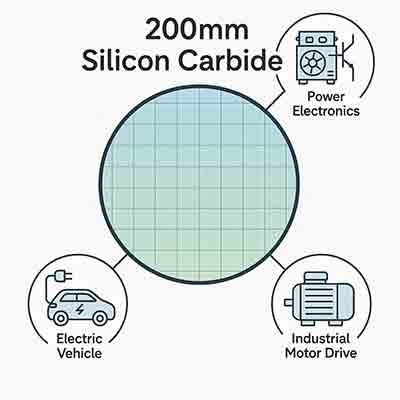200mm 4H Silicon Carbide Substrates Made In The USA
200mm SiC wafers fabricated in the United States enable high-performance, high-efficiency, and compact power devices, making them vital to the growing demands of EVs, industrial automation, and smart energy infrastructure.
4H-SiC offers better electrical performance (higher breakdown voltage and electron mobility) than 6H-SiC, making it the preferred choice for modern high-power and high-efficiency semiconductor devices, including those used in electric vehicles, power inverters, and wide-bandgap RF applications.
Get your 200mm SiC Substrate Quote FAST! Buy online and start researching today!
4H-SiC vs 6H-SiC Differences
| Property | 4H-SiC | 6H-SiC |
|---|---|---|
| Crystal Structure | Hexagonal (4-layer repeat) | Hexagonal (6-layer repeat) |
| Bandgap | ~3.26 eV (wider) | ~3.0 eV |
| Electron Mobility | ~1000 cm²/V·s (higher) | ~400 cm²/V·s (lower) |
| On-Resistance | Lower (better for power devices) | Higher |
| Preferred for | Power electronics, EVs, RF | Some optoelectronics, legacy systems |
Important 4H SiC Keywords
-
H Silicon Carbide vs 6H
-
Differences between 4H and 6H SiC
-
4H-SiC for electric vehicles
-
SiC substrate comparison
-
UniversityWafer SiC wafers
200mm SiC Product Spec - 4H -v2.1
200mm Silicon Carbide (SiC) wafers provide significant benefits in semiconductors, particularly for electric vehicles (EVs) and power electronics, due to the following key advantages:
⚡ Benefits to Semiconductors & Electric Vehicles (EVs):
-
Higher Efficiency in Power Conversion:

-
SiC devices have a wider bandgap than silicon, allowing them to operate at higher voltages and temperatures with lower energy loss.
-
In EVs, this translates to more efficient inverters, on-board chargers, and DC-DC converters, improving driving range and reducing battery size.
-
-
Smaller and Lighter Systems:
-
Because SiC handles higher voltages with less heat, it enables smaller cooling systems and compact designs, which are ideal for space-constrained EV platforms.
-
-
Faster Switching Speeds:
-
SiC transistors switch faster than silicon MOSFETs, reducing switching losses and enabling higher frequency operation—important for reducing the size of passive components like inductors and capacitors in EV powertrains.
-
🔌 Benefits to Another Device: Industrial Motor Drives
In industrial motor drives, 200mm SiC wafers help create robust power modules that:
-
Reduce power losses, increasing energy efficiency in factories.
-
Operate reliably in harsh environments (high heat, high voltage).
-
Extend the lifespan of motor systems due to lower thermal stress.
Substrate General Characteristics
| # | Requirement | All Grades |
|---|---|---|
| 1 | Polarity of faces | Optical polish: Carbon face CMP: Si face – ready for EPI |
| 2 | Edge Profile | See SEMI M55-0817 |
| 3 | Laser Marking (carbon side) | SEMI T5-1022 |
| 4 | Backside condition | Optical polish |
Resistivity
| # | Requirement | Ultra Prime p/n: 585-000302301 |
MOSFET p/n: 585-00231901 |
Unit |
|---|---|---|---|---|
| 1 | Resistivity | 0.017-0.023 | 0.015-0.025 | Ωcm |
Substrate Wafer Geometry Characteristics
| # | Requirement | Ultra Prime p/n: 5850003023-01 |
MOSFET Grade p/n: 585002319-01 |
Unit |
|---|---|---|---|---|
| 1 | Crystal Surface Orientation Axis | 4.0° towards [1120] ± 0.1 | 4.0° towards [1120] ± 0.2 | |
| 2 | Nominal wafer diameter | 200.0 ± 0.20 | mm | |
| 3 | Thickness, substrate | 500.0 ± 25 | um | |
| 4 | Total thickness variation (TTV) | ≤4.0 | ≤5.0 | um |
| 5 | 200mm notch orientation | [1120] ± 5.0° | [1120] ± 5.0° | Deg |
| 6 | Notch depth | 1.00 – 1.25 | 1.00 – 1.25 | mm |
| 7 | Warp, substrate | ≤ 30.0 | ≤ 40.0 | um |
| 8 | Bow, substrate | ≤± 25.0 | ≤± 25.0 | um |
| 9 | SBIR (LTV) MAX (10mm x 10mm) | ≤ 1.0 | um | |
| 10 | SBIR (LTV) Average (10mm x 10mm) | ≤ 0.5 | um | |
| 11 | Scratches - count | 0 | ≤5 | Count |
| 12 | Scratches - cumulative | 0 | ≤35 | mm |
| 13 | Surface roughness Si face finish | < 0.2 | nm | |
| 14 | Surface roughness C face finish | < 0.2 | nm | |
Substrate Crystallographic Characteristics
| # | Requirement | Ultra Prime | MOSFET Grade | Unit |
|---|---|---|---|---|
| 1 | MPD (MicroPipe Density) | ≤ 0.5 | ≤ 2 | per cm² |
| 2 | Maximum Foreign Polytypes | 0 | % | |
| 3 | Stains | 0 | ||
| 4 | Etch Pit Density (EPD) | ≤ 4000 | ≤ 8000 | per cm² |
| 5 | Basal plane dislocation density (BPD) | ≤ 1000 | ≤ 2000 | per cm² |
| 6 | Threading screw dislocation | ≤ 100 | ≤ 500 | per cm² |
| 7 | Stacking fault die yield (3x3mm) | >99.0 | >98.0 | % |
| 8 | Basal plane slip dislocations die yield (3x3mm) | >99.0 | >98.0 | % |
| 9 | Edge exclusion | 3 | mm | |
| 10 | Edge chips Size >0.5mm | None permitted | ||
| 11 | Cracks | None permitted | ||
| 12 | TUA (3x3mm) | >=98.0% | >=95.0% | % |
Surface Metals
| # | Element | Value | Unit |
|---|---|---|---|
| 1 | Aluminum (Al) | ≤5E11 | Atoms/cm² |
| 2 | Antimony (Sb) | ≤1E11 | Atoms/cm² |
| 3 | Arsenic (As) | ≤1E11 | Atoms/cm² |
| 4 | Barium (Ba) | ≤1E11 | Atoms/cm² |
| 5 | Beryllium (Be) | ≤1E11 | Atoms/cm² |
| 6 | Bismuth (Bi) | ≤1E11 | Atoms/cm² |
| 7 | Boron (B) | ≤5E11 | Atoms/cm² |
| 8 | Cadmium (Cd) | ≤1E11 | Atoms/cm² |
| 9 | Calcium (Ca) | ≤1E11 | Atoms/cm² |
| 10 | Chromium (Cr) | ≤1E11 | Atoms/cm² |
| 11 | Cobalt (Co) | ≤1E11 | Atoms/cm² |
| 12 | Copper (Cu) | ≤1E11 | Atoms/cm² |
| 13 | Gallium (Ga) | ≤1E11 | Atoms/cm² |
| 14 | Germanium (Ge) | ≤1E11 | Atoms/cm² |
| 15 | Iron (Fe) | ≤1E11 | Atoms/cm² |
| 16 | Lead (Pb) | Atoms/cm² | |
| 17 | Lithium (Li) | Atoms/cm² | |
| 18 | Magnesium (Mg) | ≤1E11 | Atoms/cm² |
| 19 | Manganese (Mn) | ≤1E11 | Atoms/cm² |
| 20 | Molybdenum (Mo) | ≤1E11 | Atoms/cm² |
| 21 | Nickel (Ni) | ≤1E11 | Atoms/cm² |
| 22 | Potassium (K) | ≤1E11 | Atoms/cm² |
| 23 | Sodium (Na) | ≤5E11 | Atoms/cm² |
| 24 | Strontium (Sr) | ≤1E11 | Atoms/cm² |
| 25 | Tin (Sn) | ≤1E11 | Atoms/cm² |
| 26 | Titanium (Ti) | Atoms/cm² | |
| 27 | Tungsten (W) | Atoms/cm² | |
| 28 | Vanadium (V) | ≤1E11 | Atoms/cm² |
| 29 | Zinc (Zn) | ≤1E11 | Atoms/cm² |
| 30 | Zirconium (Zr) | ≤1E11 | Atoms/cm² |
